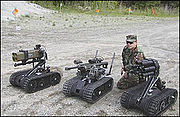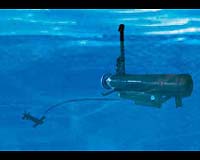War of robots
From 2007 to 2013, the United States will allocate 8.5 billion dollars to create and improve robots for warfare. In Iraq, 365 robot units of 32 types of appointments were used. But apparently this is only the beginning and other countries are also not sitting still and are creating their robots for war. It is getting hot and scary ...
I did a little research and chose the best robots for war from the USA in three categories: on land, air and under water. Maybe I was mistaken somewhere, I will be glad to hear your opinions and arguments.
Swords (short for Special Weapons Observation Reconnaissance Detection Systems) is a special combat surveillance and intelligence system.

Created by Foster-Miller TALON Robot. According to the manufacturer, the robot is designed for actions in the city, is able to predict sand, water and snow (up to 100 feet deep), as well as climb stairs.
It is controlled by the operator at a distance of up to 1000 meters.
It weighs from 100 pounds (45 kg) to 60 pounds (27 kg).
There are a number of different types of weapons that can be placed on SWORDS; M16 rifles, 5.56 mm SAW M249, 7.62 mm M240 machine gun, Barrett rifles M82 .50, six-barrel 40-mm grenade launcher or four-barrel 66 mm M202A1 FLASH.
It was applied in Afghanistan and Iraq.
The robot costs approximately $ 60,000 as standard.
AutoCopter - the car is small: two meters long, 13.6 kg without weight. Which does not stop the Americans from calling it "one of the most advanced and innovative unmanned aerial vehicles in the world, as well as the" undeniably best "in the price category of up to $ 100 thousand.

It is also the lightest, the most tenacious in the event of an accident and very “intelligent”, thanks to “neural network-based flight control algorithms”. The last passage means that AutoCopter will not allow the “pilot” to do stupid things that could have disastrous consequences.
A helicopter flies forward at a speed of 96.5 km / h, and 56 km / h sideways. The flight takes place in two modes: fully autonomous and semi-autonomous.
The TALON (Sea Tactical Littoral Ocean Network) marine robot is designed to detect submarines and minefields at a considerable distance from the warships provided. The complex is planned to be used for anti-submarine defense of ships of the LCS (Littoral Combat Ships) class of the US Navy. Multifunctional ships of the LCS class are designed to patrol maritime borders, collect intelligence, mine sweeping, hunt for submarines and high-speed boat-intruders. In special cases, these ships are capable of supporting ground operations, including as part of battle groups.

The TALON complex consists of a towed wide-range active hydroacoustic station with a remote antenna, which makes it possible to detect low-noise submarines in various hydroacoustic conditions (coastal noises, under a layer of temperature jump in sea water, etc.). The antenna is towed by an RMV (Remote Multi-Mission vehicle) underwater vehicle moving near the surface of the water and in communication with the carrier ship. The device is controlled by radio or by satellite communication system. The control algorithm allows you to tow the antenna at a given speed and change its depth of immersion, thereby ensuring the search for targets under a layer of "temperature jump" that distorts the path of the passage of acoustic signals at the boundary of two layers - warm near-surface and cold deep. The system is equipped with advanced communications, for target designation of anti-submarine weapons of ships and helicopters. The device is able to exchange information with multiple consumers in real time. The simultaneous use of two or more TALON systems allows you to get a complete picture of the underwater environment over a large area. Transportation of the complex over long distances and its maintenance is carried out on board the carrier ship.
TALON was created in the framework of the American FORCEnet plan, which implies the integration of all information systems of the U.S. Navy into a single global satellite network for the exchange of tactical information between ships, naval aviation, submarines and ground forces, in order to increase the effectiveness of military operations in the coastal zone.
Sources of information:
http://news2000.org.ua/print?a=%2Fpaper%2F9828
http://ru.wikipedia.org/wiki/Swords
http://www.membrana.ru/articles/technic/2006/ 03/02 / 210000.html
http://www.mmxxi.ru/item/35/
PS And best of all, let this iron rust and crumble!
I did a little research and chose the best robots for war from the USA in three categories: on land, air and under water. Maybe I was mistaken somewhere, I will be glad to hear your opinions and arguments.
On the land
Swords (short for Special Weapons Observation Reconnaissance Detection Systems) is a special combat surveillance and intelligence system.

Created by Foster-Miller TALON Robot. According to the manufacturer, the robot is designed for actions in the city, is able to predict sand, water and snow (up to 100 feet deep), as well as climb stairs.
It is controlled by the operator at a distance of up to 1000 meters.
It weighs from 100 pounds (45 kg) to 60 pounds (27 kg).
There are a number of different types of weapons that can be placed on SWORDS; M16 rifles, 5.56 mm SAW M249, 7.62 mm M240 machine gun, Barrett rifles M82 .50, six-barrel 40-mm grenade launcher or four-barrel 66 mm M202A1 FLASH.
It was applied in Afghanistan and Iraq.
The robot costs approximately $ 60,000 as standard.
Air
AutoCopter - the car is small: two meters long, 13.6 kg without weight. Which does not stop the Americans from calling it "one of the most advanced and innovative unmanned aerial vehicles in the world, as well as the" undeniably best "in the price category of up to $ 100 thousand.

It is also the lightest, the most tenacious in the event of an accident and very “intelligent”, thanks to “neural network-based flight control algorithms”. The last passage means that AutoCopter will not allow the “pilot” to do stupid things that could have disastrous consequences.
A helicopter flies forward at a speed of 96.5 km / h, and 56 km / h sideways. The flight takes place in two modes: fully autonomous and semi-autonomous.
On the water
The TALON (Sea Tactical Littoral Ocean Network) marine robot is designed to detect submarines and minefields at a considerable distance from the warships provided. The complex is planned to be used for anti-submarine defense of ships of the LCS (Littoral Combat Ships) class of the US Navy. Multifunctional ships of the LCS class are designed to patrol maritime borders, collect intelligence, mine sweeping, hunt for submarines and high-speed boat-intruders. In special cases, these ships are capable of supporting ground operations, including as part of battle groups.

The TALON complex consists of a towed wide-range active hydroacoustic station with a remote antenna, which makes it possible to detect low-noise submarines in various hydroacoustic conditions (coastal noises, under a layer of temperature jump in sea water, etc.). The antenna is towed by an RMV (Remote Multi-Mission vehicle) underwater vehicle moving near the surface of the water and in communication with the carrier ship. The device is controlled by radio or by satellite communication system. The control algorithm allows you to tow the antenna at a given speed and change its depth of immersion, thereby ensuring the search for targets under a layer of "temperature jump" that distorts the path of the passage of acoustic signals at the boundary of two layers - warm near-surface and cold deep. The system is equipped with advanced communications, for target designation of anti-submarine weapons of ships and helicopters. The device is able to exchange information with multiple consumers in real time. The simultaneous use of two or more TALON systems allows you to get a complete picture of the underwater environment over a large area. Transportation of the complex over long distances and its maintenance is carried out on board the carrier ship.
TALON was created in the framework of the American FORCEnet plan, which implies the integration of all information systems of the U.S. Navy into a single global satellite network for the exchange of tactical information between ships, naval aviation, submarines and ground forces, in order to increase the effectiveness of military operations in the coastal zone.
Sources of information:
http://news2000.org.ua/print?a=%2Fpaper%2F9828
http://ru.wikipedia.org/wiki/Swords
http://www.membrana.ru/articles/technic/2006/ 03/02 / 210000.html
http://www.mmxxi.ru/item/35/
PS And best of all, let this iron rust and crumble!
